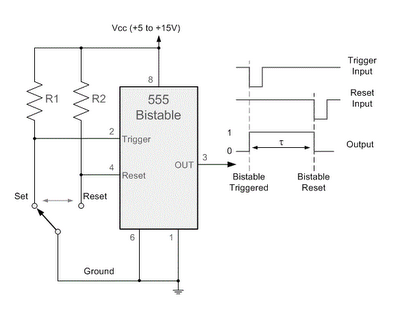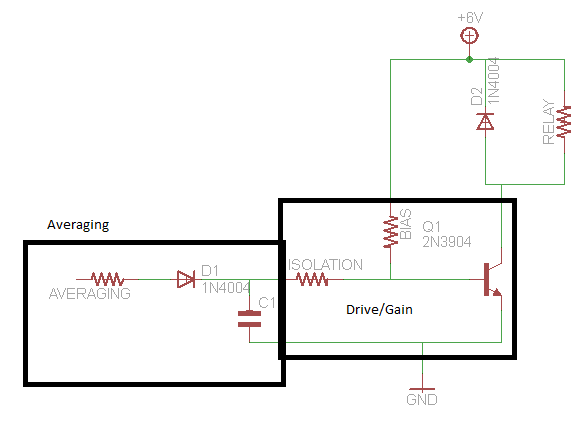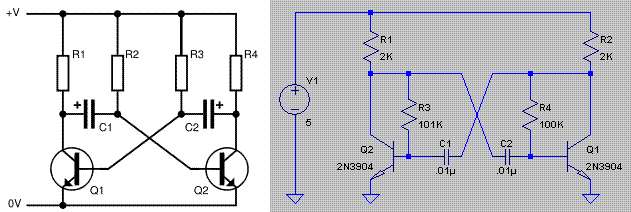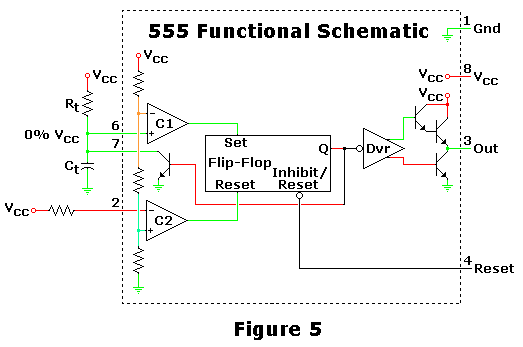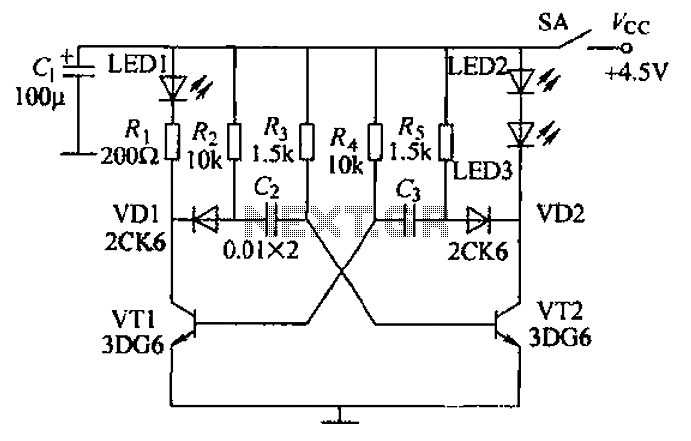
astable multivibrator transistors
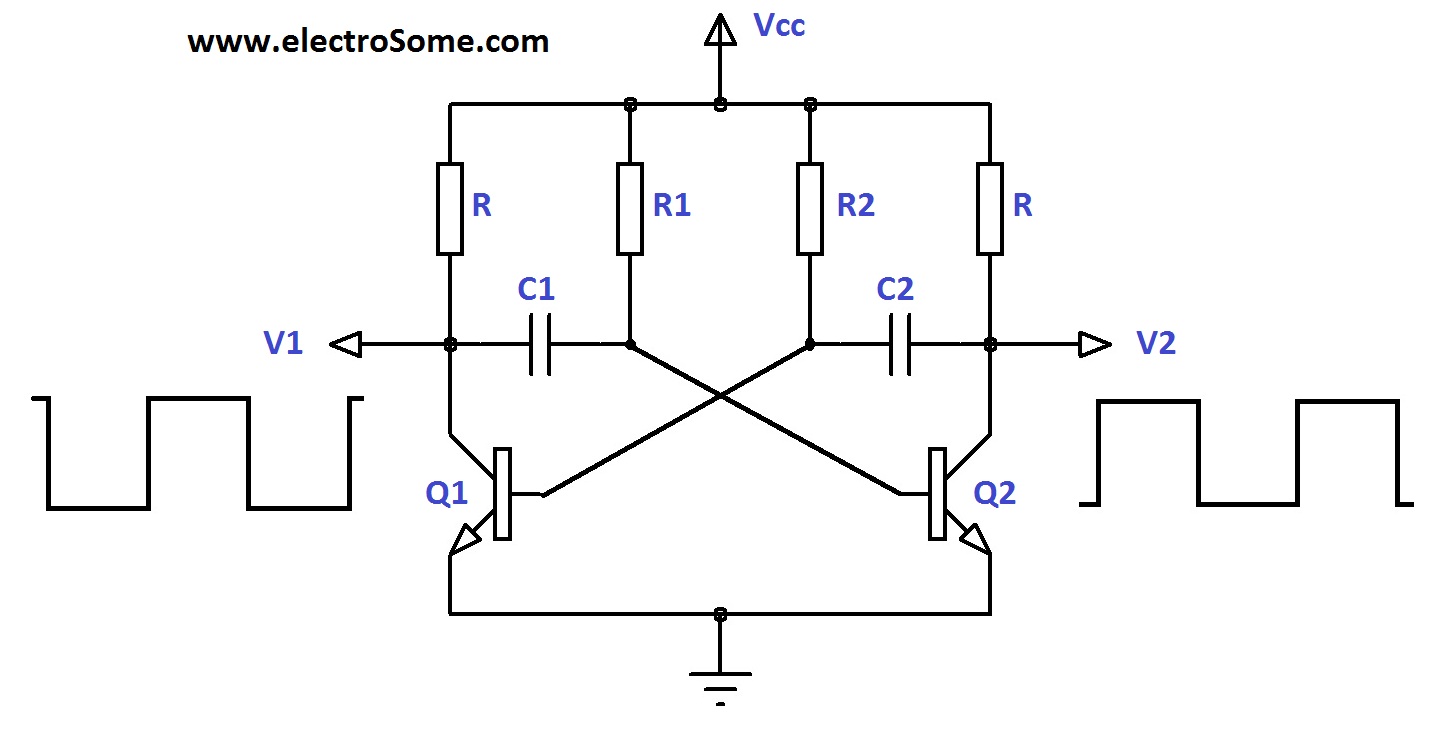
An astable multivibrator, also known as a free-running multivibrator, is a circuit that does not have stable states. Its output oscillates continuously between two unstable states without requiring external triggering. The duration of each state is determined by the resistor-capacitor (RC) time constant. The circuit typically includes two transistors configured as switches. When a transistor is in the ON state, its collector and emitter behave like a short circuit. Conversely, when it is in the OFF state, they act as an open circuit. In this configuration, when one transistor is ON, the other is OFF. The OFF time of the transistor is governed by the RC time constant. Upon powering the circuit, one transistor will initially conduct more than the other due to circuit imbalances or variations in transistor parameters. Over time, the more conductive transistor will reach saturation, while the less conductive transistor will enter cutoff. Transistor Q2 remains OFF because of the negative voltage from the discharging capacitor C1, which was charged during the previous cycle. The OFF time of Q2 is dictated by the R1C1 time constant. Once capacitor C1 charges to a voltage sufficient to provide a base-emitter voltage of 0.7V to transistor Q2, it turns ON, causing capacitor C2 to begin discharging. The negative voltage from capacitor C2 then turns OFF transistor Q1, while capacitor C1 starts charging from Vcc through resistor R and the base-emitter junction of transistor Q2, keeping Q2 in the ON state.
The astable multivibrator circuit is a fundamental component in digital electronics, often used for generating square waves or clock pulses. Its operation relies on the interplay between two bipolar junction transistors (BJTs) or field-effect transistors (FETs), which are alternately switched by the charging and discharging of capacitors.
In a typical configuration, the circuit consists of two transistors (Q1 and Q2), two resistors (R1 and R2), and two capacitors (C1 and C2). The transistors are connected in such a way that the output of one transistor feeds into the base of the other, creating a feedback loop. The resistors control the rate at which the capacitors charge and discharge, thus influencing the frequency of oscillation.
When the circuit is powered, one of the transistors will initially turn ON due to slight differences in transistor characteristics or initial conditions. This transistor will quickly saturate, pulling its collector voltage low and allowing the associated capacitor to discharge. As the capacitor discharges, it generates a negative voltage that eventually turns OFF the first transistor. Simultaneously, the second transistor begins to turn ON as its base-emitter junction receives sufficient voltage from the charged capacitor.
The oscillation continues as the capacitors alternate between charging and discharging, with the time periods of each state determined by the RC time constants of the respective capacitors and resistors. The frequency of oscillation can be adjusted by varying the resistor or capacitor values, allowing for flexible applications in timing circuits, frequency generators, and pulse-width modulation systems.
In summary, the astable multivibrator is a self-sustaining oscillator, producing square wave outputs without the need for external triggering, making it a versatile tool in various electronic applications.An Astable Multivibrator or a Free Running Multivibrator is the multivibrator which has no stable states. Its output oscillates continuously between its two unstable states without the aid of external triggering.
The time period of each states are determined by Resistor Capacitor ( RC ) time constant. In the above diagram we can find two transisto rs which is wired as a switch. Please do read the article Transistor as A Switch. When a transistor is ON, its collector and emitter act as a short circuit. But when it is OFF they acts as open circuit. So in the above circuit when a transistor is in OFF state its collector will have the voltage Vcc and when it is ON its collector will be grounded. When one transistor is ON the other will be OFF. The OFF time of transistor is determined by RC time constant. When the circuit is switched on, one of the transistor will be more conducting than the other due imbalance in the circuit or difference in the parameters of the transistor.
Gradually the more conducting transistor will be driven to Saturation and the less conducting transistor will be driven to Cutoff. Q2 is OFF due to the -ive voltage from the discharging capacitor C1 which is charged during the previous cycle.
So the OFF time of Q2 is determined by R1C1 time constant. When the Capacitor C1 charges to a voltage sufficient provide base emitter voltage of 0. 7V to the transistor Q2, it turns ON and capacitor C2 starts dischargeing. The negative voltage from the capacitor C2 turns off the transistor Q1 and the capacitor C1 starts charging from Vcc through resistor R and base emitter of transistor Q2. Thus the transistor Q2 remains in ON state. 🔗 External reference
The astable multivibrator circuit is a fundamental component in digital electronics, often used for generating square waves or clock pulses. Its operation relies on the interplay between two bipolar junction transistors (BJTs) or field-effect transistors (FETs), which are alternately switched by the charging and discharging of capacitors.
In a typical configuration, the circuit consists of two transistors (Q1 and Q2), two resistors (R1 and R2), and two capacitors (C1 and C2). The transistors are connected in such a way that the output of one transistor feeds into the base of the other, creating a feedback loop. The resistors control the rate at which the capacitors charge and discharge, thus influencing the frequency of oscillation.
When the circuit is powered, one of the transistors will initially turn ON due to slight differences in transistor characteristics or initial conditions. This transistor will quickly saturate, pulling its collector voltage low and allowing the associated capacitor to discharge. As the capacitor discharges, it generates a negative voltage that eventually turns OFF the first transistor. Simultaneously, the second transistor begins to turn ON as its base-emitter junction receives sufficient voltage from the charged capacitor.
The oscillation continues as the capacitors alternate between charging and discharging, with the time periods of each state determined by the RC time constants of the respective capacitors and resistors. The frequency of oscillation can be adjusted by varying the resistor or capacitor values, allowing for flexible applications in timing circuits, frequency generators, and pulse-width modulation systems.
In summary, the astable multivibrator is a self-sustaining oscillator, producing square wave outputs without the need for external triggering, making it a versatile tool in various electronic applications.An Astable Multivibrator or a Free Running Multivibrator is the multivibrator which has no stable states. Its output oscillates continuously between its two unstable states without the aid of external triggering.
The time period of each states are determined by Resistor Capacitor ( RC ) time constant. In the above diagram we can find two transisto rs which is wired as a switch. Please do read the article Transistor as A Switch. When a transistor is ON, its collector and emitter act as a short circuit. But when it is OFF they acts as open circuit. So in the above circuit when a transistor is in OFF state its collector will have the voltage Vcc and when it is ON its collector will be grounded. When one transistor is ON the other will be OFF. The OFF time of transistor is determined by RC time constant. When the circuit is switched on, one of the transistor will be more conducting than the other due imbalance in the circuit or difference in the parameters of the transistor.
Gradually the more conducting transistor will be driven to Saturation and the less conducting transistor will be driven to Cutoff. Q2 is OFF due to the -ive voltage from the discharging capacitor C1 which is charged during the previous cycle.
So the OFF time of Q2 is determined by R1C1 time constant. When the Capacitor C1 charges to a voltage sufficient provide base emitter voltage of 0. 7V to the transistor Q2, it turns ON and capacitor C2 starts dischargeing. The negative voltage from the capacitor C2 turns off the transistor Q1 and the capacitor C1 starts charging from Vcc through resistor R and base emitter of transistor Q2. Thus the transistor Q2 remains in ON state. 🔗 External reference

